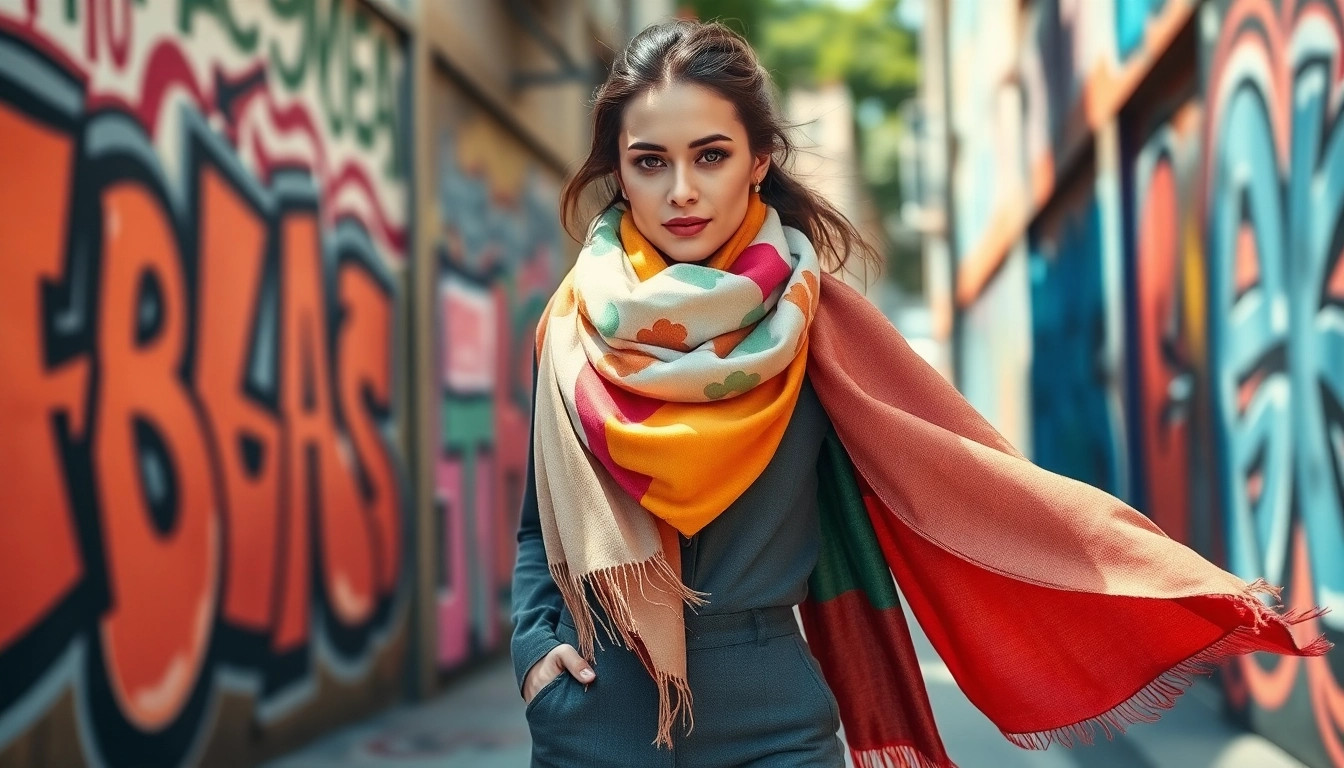Introduction to Scarves
Scarves are one of the most versatile accessories in modern fashion, providing both style and functionality. Whether it’s a luxurious silk piece draped elegantly around the neck or a cozy wool wrap worn during chilly winter days, the options are endless. From casual outings to formal events, scarves can elevate any outfit, adding depth and character to your look. In this article, we will explore the multifaceted world of scarves, delving into their history, types, and how to incorporate them into your wardrobe.
Understanding the Versatility of Scarves
The beauty of scarves lies in their adaptability. They can transition seamlessly from season to season and occasion to occasion. Scarves serve various purposes: they provide warmth, add a splash of color, or serve as a statement piece that ties an outfit together. With countless patterns and materials available, a scarf can also reflect personal style preferences, making them a staple for any wardrobe.
History and Cultural Significance of Scarves
Scarves have a rich history that spans centuries, tracing their roots back to ancient civilizations. Initially, they were worn primarily for practical purposes, such as to protect against the elements. Over time, however, scarves evolved into symbols of luxury and fashion. In various cultures, scarves signify social status or identity; for instance, some traditional headscarves have deep cultural meanings and convey respect and tradition. Understanding this history enhances appreciation for scarves as more than just a mere accessory but as pieces that embody culture and heritage.
Popular Materials Used in Scarves
The choice of material significantly affects the look, feel, and functionality of a scarf. Here are some of the most popular materials:
- Silk: Renowned for its luxurious feel and elegant drape, silk scarves are perfect for formal settings and can easily elevate a simple outfit.
- Wool: Ideal for cold weather, wool scarves provide excellent warmth while offering various textures.
- Cashmere: Soft and luxurious, cashmere scarves are perfect for adding a touch of elegance and sophistication.
- Cotton: Lightweight and breathable, cotton scarves are excellent for warmer months and casual wear.
- Polyester: Often used for affordable fashion scarves, this material is practical and easy to care for.
Choosing the Right Scarves for Your Style
Selecting the right scarf involves understanding your personal style and how you can incorporate it into your wardrobe. Key factors to consider include the color palette, the scarf’s material, and the intended use. Here are some insights for making the best choice.
How to Match Scarves with Your Outfit
The right scarf can enhance any outfit, but pairing it correctly requires a bit of knowledge about color theory and patterns. Here are some guidelines:
- Complementary Colors: Scarves can be chosen based on complementary colors to enhance the visual appeal of your outfit.
- Patterns: When wearing a patterned outfit, opt for a solid-color scarf to avoid clashing. Conversely, a bold patterned scarf can add excitement to a plain outfit.
- Layering: Consider the overall layering of your attire. A chunky knit scarf pairs well with a fitted coat, while a lightweight scarf works excellently with a structured jacket.
Seasonal Scarves: What to Wear When
Seasonality plays a crucial role in scarf selection. Here’s a brief overview by season:
- Spring: Light cotton or silk scarves are ideal, offering a pop of color without bulk.
- Summer: Look for airy, breathable fabrics that can easily be tied or wrapped.
- Autumn: Choose medium-weight materials with warm tones to match the seasonal shift.
- Winter: Thick wool or cashmere scarves are crucial for warmth, often in neutral or vibrant hues.
Occasions to Wear Scarves
Scarves are suitable for various occasions, making them an essential accessory. Here are some common scenarios to consider:
- Casual Outings: A colorful cotton scarf can add flair to a jeans-and-t-shirt combo.
- Formal Events: Silk scarves elevate evening wear, adding sophistication and elegance.
- Work: A sleek, professional scarf can complement office attire, providing a polished edge.
- Travel: A functional scarf can double as a wrap or blanket during flights and help with temperature regulation.
- Seasonal Celebrations: Match scarves with festive colors or patterns during holidays for a jolly touch.
Different Styles and Types of Scarves
Scarves come in a wide variety of styles and types, each serving a unique purpose. Understanding the nuances can help you make informed decisions when building your scarf collection.
Fashion Scarves: Trends and Tips
When it comes to fashion scarves, trends change frequently. Keeping up with current styles while developing a timeless collection is essential. Popular trends include oversized scarves, color-blocking, and unique textures. Pairing a trendy scarf with a classic wardrobe can breathe new life into your style while ensuring longevity.
Functional Scarves: Warmth and Comfort
Especially necessary during the colder months, functional scarves prioritize warmth without sacrificing style. Features such as built-in hoods, pockets, or being made from thermal materials enhance both comfort and utility while maintaining a fashionable look.
Artisan and Handmade Scarves
Artisanal scarves offer unique designs that often reflect cultural heritage and craftsmanship. Investing in handmade pieces not only supports artisans but also adds exclusive items to your collection that are unlikely to be found elsewhere.
Creative Ways to Wear Scarves
Scarves can be styled in numerous creative ways beyond traditional wrapping around the neck. Here are some innovative styling techniques:
Innovative Styling Techniques for Scarves
Experimenting with different styles can elevate your scarf game:
- Headwrap: Great for summer days, especially for protecting hair from sun damage.
- Belting: Use a scarf as a belt for dresses or oversized shirts to add a touch of personality.
- Bag Accessory: Tying a scarf around the handle of your handbag adds flair and color.
- Shawl: Drape a larger scarf over your shoulders for a chic layering effect, especially during colder months.
Accessorizing with Scarves: Beyond the Neck
Scarves can also be used as accessories in other contexts. Here are some ideas:
- Wrist Wrap: Wrap a thin scarf around your wrist as a playful bracelet substitute.
- Hair Accessories: Use a scarf to tie your hair into a bun or ponytail for added style.
- Evening Wrap: A silk scarf can double as a wrap for chilly evenings out.
Layering Scarves for Different Looks
Layering scarves can create visually interesting outfits. To achieve this, consider:
- Combining different textures for a balanced look—think a chunky knit over a silky base.
- Varying lengths: Pair a short scarf with a long one to create an eye-catching asymmetrical effect.
- Exploring different knot styles to add dimension; experiment with loops, knots, and draping techniques.
Caring for Your Scarves
Proper care is essential to maintain the quality and appearance of your scarves. Here’s how to keep them looking their best:
Washing and Storing Scarves Properly
Different materials require different care methods. Generally, follow these steps:
- Always check the care label for specific instructions on washing and drying.
- For delicate materials like silk, hand wash in cold water with mild detergent.
- Store scarves in a cool, dry place; hanging them or rolling them can prevent creasing.
Repairing Damaged Scarves
Accidents happen, and scarves may get snags or stains. Prompt attention can save your favorite pieces:
- For small snags, use a needle to tuck the loose threads back in.
- Address stains promptly with appropriate cleaners—test on a small area first.
- Consider reweaving or mending by a professional for significant damages.
Tips for Maintaining Scarves’ Quality
To extend the life of your scarves, consider these practices:
- Rotate your collection regularly to avoid wear on frequently used scarves.
- Keep them away from direct sunlight to prevent color fading.
- Regularly inspect for potential damages, and treat them before they worsen.



